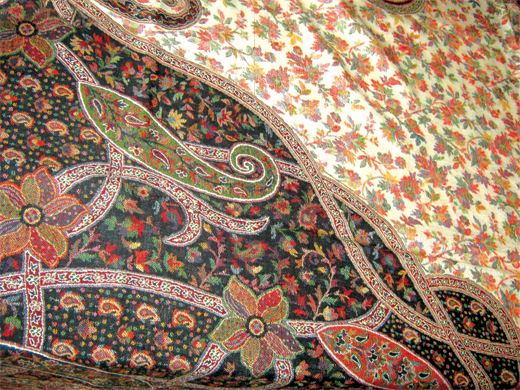Kashmir shawls are known for their intricacies, variety, material, designs and that exquisite look. It has entered the pages of history and has had an association with emperors and kings, queens and kingdoms. Sometimes it was presented as a gift and at other times paid as ransom as well. Syed Asma reports.

Kashmir continues the legacy of making beautiful shawls. And, the Kani Shawl, the most intricate weave, is the king of these all.
Unlike other shawls Kani shawls are woven by using numerous wooden spokes locally known as Kanis. Kanis are fine, slightly bulged and eyeless wooden needles, pointed on both ends, with different coloured threads tightly rolled over them. These multi coloured threads decide the colour scheme in the shawl later.
It is either woven as a plain spread or with embroidery of different styles and patterns and many colours. Earlier it was made in bits and pieces which were later finely stitched together by a craftsman but now these are preferred to be woven in one piece only.
Also known as Jamawar, Kani shawls have been a choice of kings and courtiers, historical record shows. It is also said that Kani shawls taken as a sign of being royal and rich had attracted buyers from all over the world, mostly from Europe. Kani Jamawar was one of the fashionable attires of European aristocratic women. Its huge market had tempted many to copy this art but they failed.
This time also many imitators are trying their hands and spoiling the market for the original product, its artisans say.
But Kani Shawl has now been registered under the Geographical Indication of Goods Act in India which is an acknowledgment of the fact that this handicraft is unique and specific to Kashmir. The GI gets this Shawl legal protection in the market place, officials say.
Men, apart from using the whole spread mostly referred to as as dussa locally, also used to stitch stylish coats of these Jamawars. Many historical paintings show that emperors, kings and queens have been wearing stylish outfits of kani jamawars.
Presently, many innovations are tried on the pretext of keeping this craft alive. Besides Jamawars and shawls, kani stoles, mufflers and scarfs are also available in the market. In addition to these Kani woven Pashmina wool suits are also available in the local market. New designs and variety is also being tried out. Checks and stripes on kani products are among the latest designs that the local artisans are working on. They say the response in the market to these innovations has been good which can help revive kani shawl’s market more robustly. Original Kani shawls are very expensive but have a huge international market its dealers say.
Like other Kashmiri shawls the material used in Kani shawl is the Pashmina as Shahtoosh is not being used because of a ban globally.
The type of wool used and the kind of embroidery done on it determine the price of the Jamawar. Shahtoosh jamawar was the most expensive followed by the one made of Pashmina. Raffal jamawar follows the two, and about the rest of the variety the cost depends on the counts of wool used. The more the counts of wool used the higher is the price of the product.
The most commonly seen motif on these Kani shawls is mango shaped almond locally known as badam.
These hand made products take a lot of time to complete and that is one of the reasons pushing its prices higher.
The kani woven products can cost anything between a few thousands rupees to many lakhs depending upon the material used, designs and density of embroidery. A two meters long and 27 inches wide stole takes a weaver five days to complete, if it’s a plain piece. The same measure with embroidery takes five to six months to complete. Sometimes a full size shawl can take an artisan or a group of them as long as three years to complete. A well known researcher Sir John Irwin, seeing the similarity between Kashmir’s Kani weaving technique and Western Europe’s tapestry weaving termed it as the twill tapestry weave. Irwin was a keeper at the Victoria and Albert Museum, London.
The Kani shawls and the colour schemes used in these Jamawars are read from a written instruction known as talim locally. This talim consists of particular codes which represent the design and the colour scheme for the shawl under weaving and are read only by professionals. The other handicraft that has the coded language is carpet. Now both are read by a software.
Ashfaq Khan: The Naqash Man
 Responsible for managing the digital divide in handicrafts, engineer Ashfaq Khan created Naqash, a software in 1998 that converts the coded blueprint of carpets into a design and vice versa. The efficient software can even be used to copy most intricate designs even if they are partially available. Though it is not known how many old designs have been saved with this software, but Khan continued working and developed a portable dyeing machine for handicrafts industry that can produce 15 million shades. He also partnered with the IICT to produce a lightweight power loom that has improved production capacity and is less cumbersome.
Responsible for managing the digital divide in handicrafts, engineer Ashfaq Khan created Naqash, a software in 1998 that converts the coded blueprint of carpets into a design and vice versa. The efficient software can even be used to copy most intricate designs even if they are partially available. Though it is not known how many old designs have been saved with this software, but Khan continued working and developed a portable dyeing machine for handicrafts industry that can produce 15 million shades. He also partnered with the IICT to produce a lightweight power loom that has improved production capacity and is less cumbersome.













